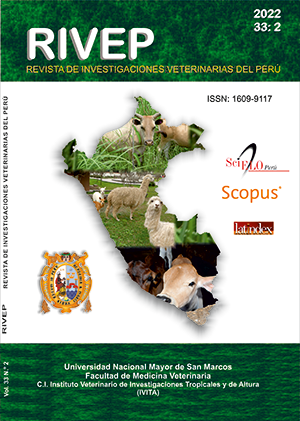Helminthiasis in vicuñas (Vicugna vicugna) in the district of Contumaza (Cajamarca, Peru)
DOI:
https://doi.org/10.15381/rivep.v33i2.22629Keywords:
chaccu, wild camelids, helminths, nematodes, cestodesAbstract
The aim of this study was to estimate the prevalence and burden of gastrointestinal helminths in vicuñas in the district of Contumaza, Cajamarca, as well as to determine their association with the variables of age and sex and to identify the parasitic genera. During August 2015, 208 vicuñas were trapped in the chaccu organized by the peasants and faeces were collected from the rectum. The samples were analysed using the qualitative techniques of flotation with Sheather’s solution and spontaneous sedimentation to detect the presence of helminth eggs and Fasciola hepatica, respectively. The parasite load was estimated using the modified McMaster method. In addition, larvae culture was made with the Baermann technique. The prevalence of helminths was 81.3 ± 5.3% and the prevalence of Strongylus-type eggs, Nematodirus, Trichuris, Capillaria and Moniezia was 61.1, 39.4, 26.9, 16.8 and 8.7% respectively. F. hepatica eggs were not found. The logistic regression test determined that age was a risk factor for the presence of helminths (p<0.05) where vicuñas <1 year and 1-3 years old presented 7.99- and 4.59-fold higher risk of presenting helminths than vicuñas >3 years. The mean parasitic load of nematodes ranged from 103.8 to 121.3 epg, corresponding to a slight load. The genera of infective larvae of the Trichostrongylidae family identified were Cooperia, Trichostrongylus, Ostertagia, Oesophagostomum, Haemonchus and Bunostomum.
Downloads
Downloads
Published
Issue
Section
License
Copyright (c) 2022 Joao Curay C., Amanda Chávez V., Rosa Pinedo V., Néstor Falcón P.

This work is licensed under a Creative Commons Attribution 4.0 International License.
AUTHORS RETAIN THEIR RIGHTS:
a. Authors retain their trade mark rights and patent, and also on any process or procedure described in the article.
b. Authors retain their right to share, copy, distribute, perform and publicly communicate their article (eg, to place their article in an institutional repository or publish it in a book), with an acknowledgment of its initial publication in the Revista de Investigaciones Veterinarias del Perú (RIVEP).
c. Authors retain theirs right to make a subsequent publication of their work, to use the article or any part thereof (eg a compilation of his papers, lecture notes, thesis, or a book), always indicating the source of publication (the originator of the work, journal, volume, number and date).










